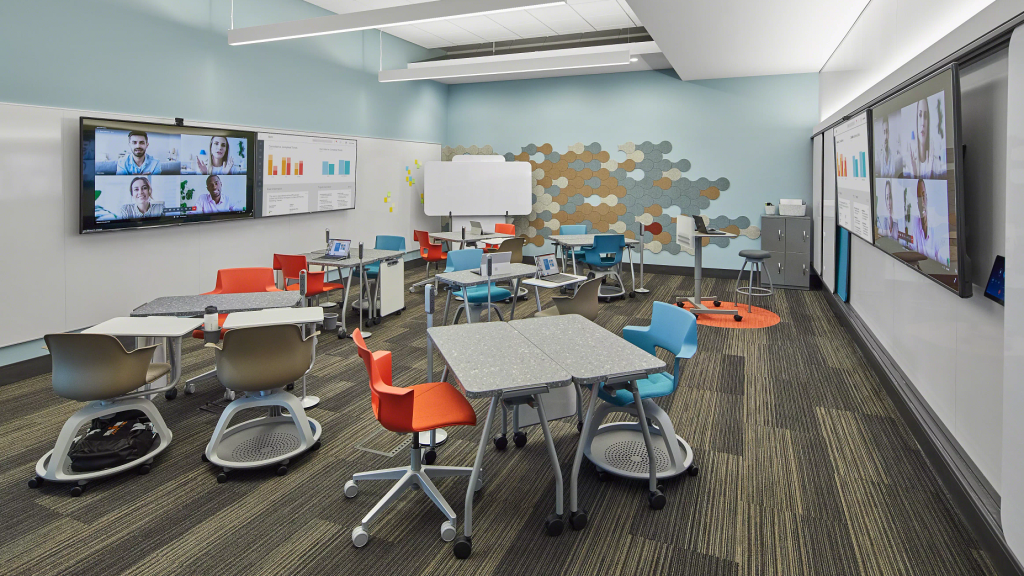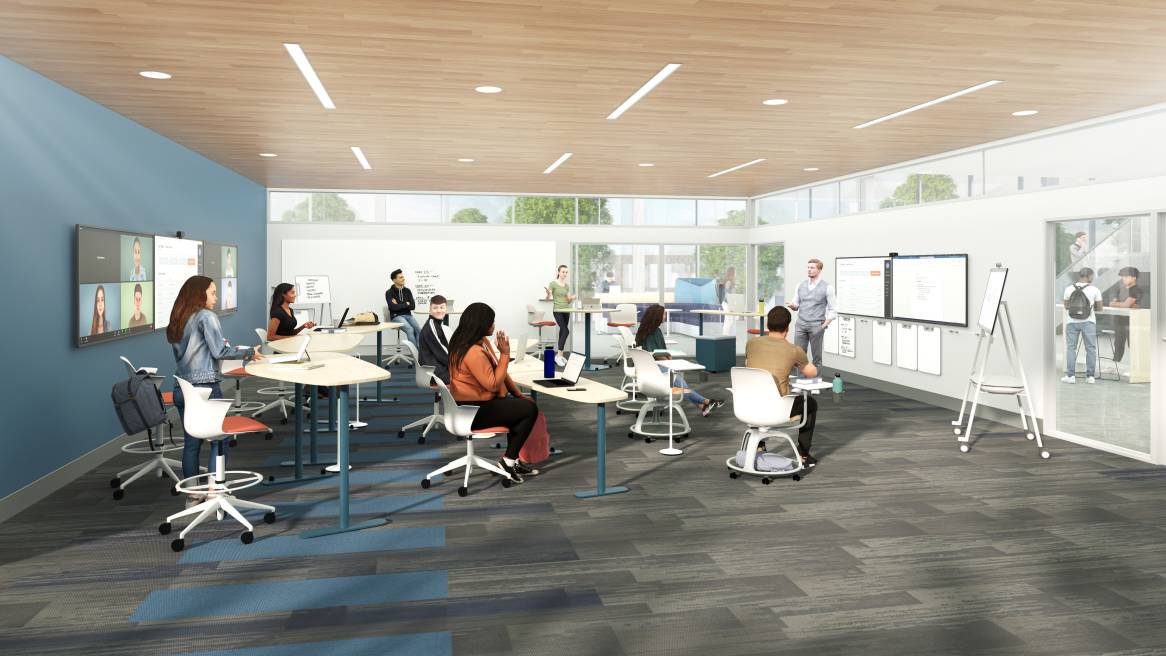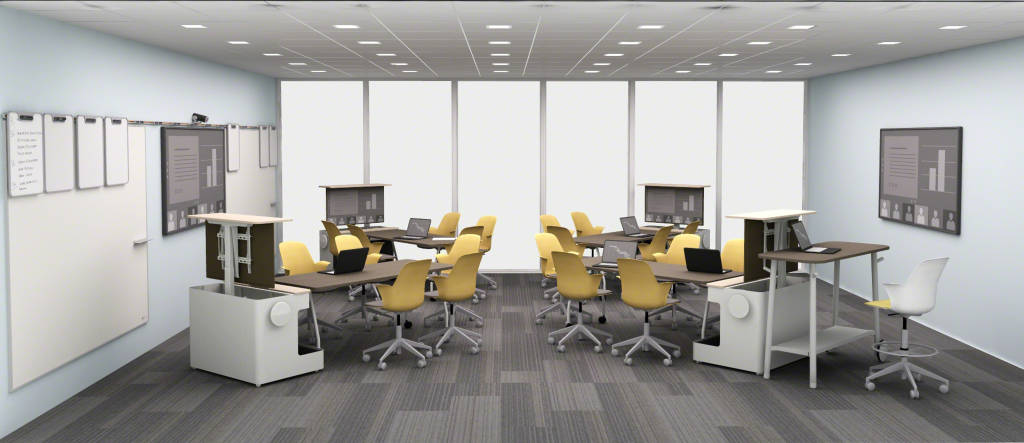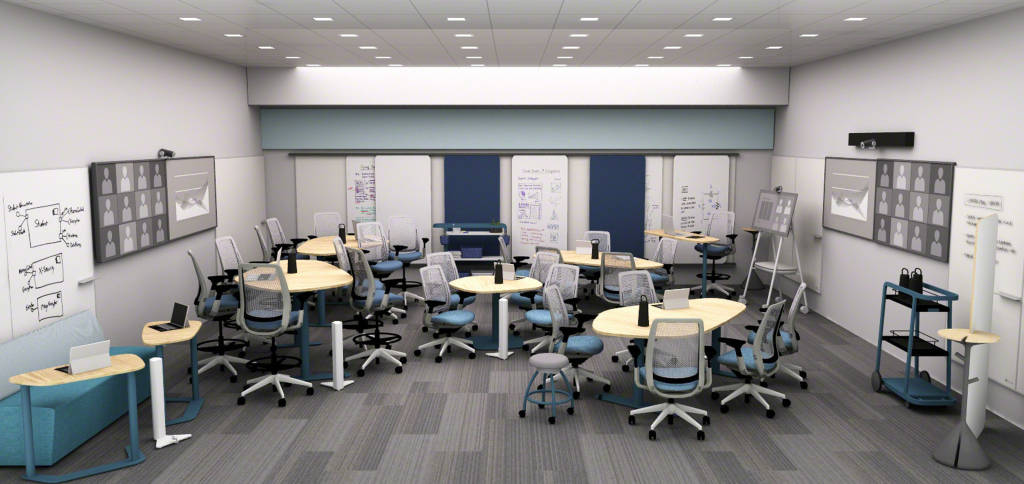Three Concepts for Creating Better Hybrid Learning Spaces
Reducing the gap between in-person and remote learning experiences
It’s been far from easy. But learning didn’t just survive COVID-19. Instead, by breaking down barriers and resistance to hybrid, HyFlex and blended learning models, the pandemic fast-forwarded opportunities for learning to thrive as it never has before — in all types of institutions and at all levels, from kindergarten to corporate.
“We’ve all experienced tremendous challenges these past two years with remote communication, remote collaboration and remote learning. At the same time, our familiarity with teleconferencing has never been higher – it’s how we’ve stayed connected throughout the pandemic,” observes Tim Elms, director at Steelcase Learning.
“We can now build on those skills as we come back together. At the heart of this transition is that we have come to appreciate more than ever there is still a need for in-person human interaction. But what’s different now is we’re also bringing in counterparts who are calling in remotely. We now accept that as a norm, as a means of bringing people in and having them actively participate and contribute. It’s a new model of learning and collaboration that is not going away.”
“Hybrid is happening, and it’s hard,” acknowledges Elms. “It’s clear that there is no one-size-fits-all solution. However, as we’ve studied the challenges and listened to our partners in education and tech, we’ve gained insights into the big shifts that are occurring. We’ve been able to take everything we learned and apply it to ideas for creating inspiring spaces that can benefit all learners, no matter which side of the screen they’re on.”
“Hybrid learning” is the term now widely used to describe a blend of in-classroom teaching with learning from home or elsewhere. As in-person learning opportunities resume, many institutions are struggling to identify a model of hybrid that’s right for them.

Confronting the Challenges
Hybrid is a tectonic shift with a wide-ranging impact that can’t be ignored.
Creating effective hybrid learning environments demands tech integration that goes well beyond just worrying about hardware, connectors and cables. Still, no technology can solve the challenges of hybrid on its own, no matter how advanced or how many bells and whistles it has. In fact, technology can sometimes be part of the problem versus a meaningful part of the solution. Screens can create their own “center of gravity” and pull students away from each other. Virtual learning may be solitary and isolating. And large group video broadcasts can make it easy for learners to feel “lost.”
For hybrid learning to truly succeed, the virtual and the physical need to coexist in the same space as seamlessly as your smartphone supports talking and texting. For that to happen, the built environment needs to step up and do more.
To achieve the deeper, richer learning experiences we all want, learning spaces need technology that’s easy to use and effective. They need to equitably support learning activities for both in-room and remote participants. And everyone, no matter where they are, must be seen and heard.
Another important development: Students are bringing functions of teleconferencing into learning spaces. For example, in-room students still like to use chat features and share digital content with the push of a button. This elevated use of technology needs to be addressed with power, large displays and easy content-sharing capabilities.
Unfortunately, most classrooms simply haven’t been designed to support such a full load. What’s more, as online activities extend the time and spaces needed in classrooms for virtual interactions, adjacent spaces — labs, libraries and lounges, for example — also begin to take on different roles.
“Lights, Camera, Audio, Content!”
“When a person is participating in a class remotely, they typically have a very compromised experience,” explains Elms. “They wonder, can people hear me and see me, will I be able to follow the interaction in the room? These are real barriers that separate in-room and remote learners. The impact on learning is profound.”
To solve this problem, planners and designers now need to think more like movie directors, says Elms, and consider elements such as lighting, camera locations, the audio experience and how content can be shared in the space.
Three Key Principles
Among the outputs of Steelcase’s research are these three key principles for creating spaces that support better hybrid experiences:
Inclusivity
Break down the barriers that separate remote and in-room classmates/participants. Ensure everyone is seen, heard, can share content and has equal ability to contribute their thoughts and ideas.
Some things to consider:
- Provide flexible furniture and mobile virtual displays so people inside the room can move around freely and so monitors displaying remote participants aren’t always the focal point of the room.
- Support the use of both shared and individual devices that make it easy for remote team members to identify people and read facial expressions.
- Select lighting that can help people look and feel confident on video.
- Evaluate everything that affects acoustics: the size of the space, boundaries, materials, and the direction of microphones and speakers. Everyone in the room and beyond it needs to hear and be heard.
Engagement
Design experiences across a range of settings that are inviting, comfortable and make collaboration easy.
Some things to consider:
- Design layouts that provide optimal sightlines to people (remote participants and those onsite) and content (digital and analog) to ensure equal participation.
- Consider software platforms and integrated technology systems that allow people and content to be displayed separately, creating a more equitable experience for remote participants.
- Design for the camera’s viewing range (90-120 degrees) to ensure people and content can be seen by remote participants.
- Include tools such as whiteboard cameras or digital whiteboards that provide equal access to information and support multiple modes of collaboration.
Ease
Design for a variety of intuitive, easy-to-navigate virtual and physical experiences.
Some things to consider:
- Enable simple and seamless transitions across multiple interfaces and displays.
- Choose furniture that’s easy-to-move and supports transitions and clear sightlines to people and content for remote and onsite participants.
- Design for a range of technology experiences that work with a variety of devices and software platforms.
The Rooms Where It Happens
Through research and experience, Steelcase has created four learning space applications that successfully integrate technology in physical space to fully support hybrid teaching and learning.
In the Plug and Play + classroom, a variety of activity zones allows students to find their best place to learn — whether that’s alone, in pairs, as teams or together in whole group discussions with virtual learners. Everything is versatile and movable to flex with different learning modes while everyone remains visible to remote classmate
In the Zoom Room classroom, learning can seamlessly flow between activities. It’s a small space that accommodates about a dozen people on site. At the same time, it’s focused on providing connectivity to engage a much larger virtual audience.
In the Digital Learn Lab, learners co-create together in small groups — whether that means in-person collaboration or connecting synchronously and virtually. Learning toggles effortlessly between lecture mode and project-based. The goal is to empower greater student engagement in small teams by encouraging deeper focus.
In the Learning Studio, the focus is on interactive and collaborative learning. Teaching occurs in groups and through peer-to-peer learning. The technology is designed to alleviate presence disparity and elevate the virtual experience. By allowing control of four different camera angles in the space, it brings remote participants into every mode of learning so they don’t miss any of the action.






